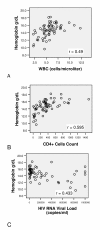Risk factors and correlates for anemia in HIV treatment-naïve infected patients: a cross-sectional analytical study
- PMID: 20727136
- PMCID: PMC2941498
- DOI: 10.1186/1756-0500-3-230
Risk factors and correlates for anemia in HIV treatment-naïve infected patients: a cross-sectional analytical study
Abstract
Background: Hematologic manifestations of the human immunodeficiency virus (HIV) infection are a well-recognized complication of the disease and may be clinically important. Our objective was to determine the risk factors for anemia and its correlation with HIV treatment-naïve infected patients without co-infection or opportunistic diseases.
Findings: We performed a cross-sectional comparative study in which HIV treatment-naïve infected patients with anemia were compared with a control group of HIV patients without anemia. The interrelationship between risk factors and anemia was determined. Odds ratio and 95% confidence intervals were calculated, to adjust for the effects of potential confounders and we used a logistic regression model. Pearson's correlation coefficient was obtained to calculate the correlation between risk factors and hemoglobin.We enrolled 54 men and 9 women. Anemia was found in 13 patients; prevalence .20 (CI 95% 0.12-0.32). Severe anemia was found in only one patient (1.5%). Only CD4+ Cells Count <200 cells/mm3 was associated with increased risk of anemia in the multivariate analysis. There was a moderately strong, positive correlation between WBC and hemoglobin (r = 0.49, P < 0.001) and between CD4+ cell count and hemoglobin (r = 0.595, P < 0.001) and a moderately strong, negative correlation between HIV RNA viral load and hemoglobin (r = - 0.433, P < 0.001).
Conclusions: Anemia is a common manifestation in the Mexican population without antiretroviral therapy. In HIV naïve patients a CD4+ Cell Count < 200 cells/mm3 was associated with an increased risk of anemia. There is a positive correlation between hemoglobin and CD4+ cell count.
Figures

Similar articles
-
Prevalence of anemia and correlation with biomarkers and specific antiretroviral regimens in 9690 human-immunodeficiency-virus-infected patients: findings of the Anemia Prevalence Study.Curr Med Res Opin. 2007 Feb;23(2):343-55. doi: 10.1185/030079906X162683. Curr Med Res Opin. 2007. PMID: 17288689
-
Correlation between HIV viral load and aminotransferases as liver damage markers in HIV infected naive patients: a concordance cross-sectional study.Virol J. 2009 Oct 30;6:181. doi: 10.1186/1743-422X-6-181. Virol J. 2009. PMID: 19878552 Free PMC article.
-
Intestinal parasitosis in relation to CD4+T cells levels and anemia among HAART initiated and HAART naive pediatric HIV patients in a Model ART center in Addis Ababa, Ethiopia.PLoS One. 2015 Feb 6;10(2):e0117715. doi: 10.1371/journal.pone.0117715. eCollection 2015. PLoS One. 2015. PMID: 25658626 Free PMC article.
-
Associations of gender and serum total cholesterol with CD4+ T cell count and HIV RNA load in antiretroviral-naïve individuals in Addis Ababa.BMC Public Health. 2018 Jul 31;18(1):943. doi: 10.1186/s12889-018-5852-4. BMC Public Health. 2018. PMID: 30064395 Free PMC article.
-
Epidemiology of anemia in human immunodeficiency virus (HIV)-infected persons: results from the multistate adult and adolescent spectrum of HIV disease surveillance project.Blood. 1998 Jan 1;91(1):301-8. Blood. 1998. PMID: 9414298 Review.
Cited by
-
Magnitude and associated factors of anemia among AZT based HAART experienced adult HIV patients at University of Gondar Comprehensive Specialized Referral Hospital, Northwest, Ethiopia, 2019: a retrospective cohort study.BMC Infect Dis. 2021 Sep 28;21(1):1016. doi: 10.1186/s12879-021-06712-5. BMC Infect Dis. 2021. PMID: 34583644 Free PMC article.
-
Severity and Determinants of Anemia in TB/HIV Coinfected Adults at Mekelle, Ethiopia: Hospital Based Retrospective Study.J Trop Med. 2023 May 17;2023:5555030. doi: 10.1155/2023/5555030. eCollection 2023. J Trop Med. 2023. PMID: 37234694 Free PMC article.
-
Prevalence and related factors of anemia in HAART-naive HIV positive patients at Gondar University Hospital, Northwest Ethiopia.BMC Hematol. 2013 Aug 9;13(1):8. doi: 10.1186/2052-1839-13-8. BMC Hematol. 2013. PMID: 24238076 Free PMC article.
-
Incidence and predictors of anemia among adults on HIV care at South Gondar Zone Public General Hospital Northwest Ethiopia, 2020; retrospective cohort study.PLoS One. 2022 Jan 12;17(1):e0259944. doi: 10.1371/journal.pone.0259944. eCollection 2022. PLoS One. 2022. PMID: 35020736 Free PMC article.
-
Predictors of Anemia Among Adult HIV Positive Patients on First-Line Antiretroviral Therapy in Northwest Ethiopia: A Retrospective Follow-Up Study.HIV AIDS (Auckl). 2021 Apr 29;13:455-466. doi: 10.2147/HIV.S280338. eCollection 2021. HIV AIDS (Auckl). 2021. PMID: 33958896 Free PMC article.
References
-
- Evans RH, Scadden DT. Haematological aspects of HIV infection. Baillieres Best Pract Res Clin Haematol. 2000;13:215–230. - PubMed
LinkOut - more resources
Full Text Sources
Research Materials

